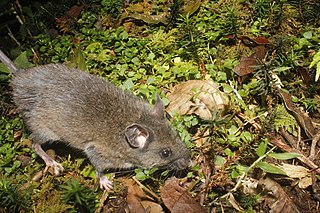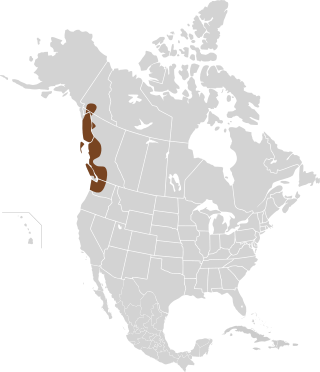The canyon mouse is a gray-brown mouse found in many states of the western United States and northern Mexico. Its preferred habitat is arid, rocky desert. Vegetation has little or no effect on the distribution of canyon mice, it is instead associated with rocky substrate than any plant. Canyon mice forage in areas with shrub-like vegetation which can be used for protection against predators. It is the only species in the Peromyscus crinitus species group.
Burt's deer mouse is a species of rodent in the family Cricetidae. It is endemic to Mexico, where it is found only on Montserrat Island off the east coast of Baja California Sur. The species is threatened by predation by feral cats.
Eva's desert mouse is a species of rodent in the genus Peromyscus of the family Cricetidae found only in the Baja California peninsula of Mexico.
The big deer mouse is a species of rodent in the family Cricetidae. It is found only in Guatemala.
Osgood's mouse is a species of rodent in the family Cricetidae. It is found only in Mexico. Its name references Wilfred Hudson Osgood.
The Guatemalan deer mouse is a species of rodent in the family Cricetidae. It is found in Guatemala and Mexico.
The naked-eared deer mouse is a species of rodent in the family Cricetidae. It is found in El Salvador, Guatemala, Honduras, Mexico, and Nicaragua.
The San Lorenzo mouse is a species of rodent in the family Cricetidae. It is endemic to Mexico, where it is found only from the islands of San Lorenzo Norte, San Lorenzo Sur, and Salsipuedes off the east coast of Baja California. The species is threatened by predation by feral and domestic cats, particularly on San Lorenzo Sur.
The Maya mouse is a species of rodent in the family Cricetidae. It is found only in Guatemala.
The brown deer mouse is a species of rodent in the family Cricetidae found only in Mexico.

The black-wristed deer mouse is a species of rodent in the family Cricetidae. It is found in the Sierras de Zempoaltépec, Juárez, and Mazteca, sub-ranges of the Sierra Madre de Oaxaca in southern Mexico, between 1,500 and 2,500 meters elevation.
The black-tailed mouse is a species of rodent in the family Cricetidae endemic to Mexico.

The mesquite mouse, also known as Merriam's deermouse, is a species of rodent in the family Cricetidae found in Mexico and Arizona, United States.
The northern rock mouse is a species of rodent in the family Cricetidae. It is found in Mexico and the United States.

The El Carrizo deer mouse is a species of rodent in the family Cricetidae. It is found only in Mexico.

The northwestern deer mouse or Keen's mouse is a species of rodent in the family Cricetidae. It is found in British Columbia in Canada and in Alaska and Washington in the United States. It was named after the Rev. John Henry Keen in 1894.
The Chihuahuan mouse is a species of rodent in the family Cricetidae.
The gleaning mouse is a species of rodent in the family Cricetidae. It is found only in Mexico.
The San Esteban Island mouse is a species of rodent in the family Cricetidae. It is endemic to Mexico, where it is known only from San Esteban Island in the northern Gulf of California.
Stirton's deer mouse is a species of rodent in the family Cricetidae. It is found in El Salvador, Guatemala, Honduras, and Nicaragua. P. stirtoni is widely distributed and is presumed to have a large population and a tolerance of habitat destruction, though its biology is poorly understood. The species is named after Ruben A. Stirton (1901-1966), an American zoologist associated with the University of California at Berkeley.





